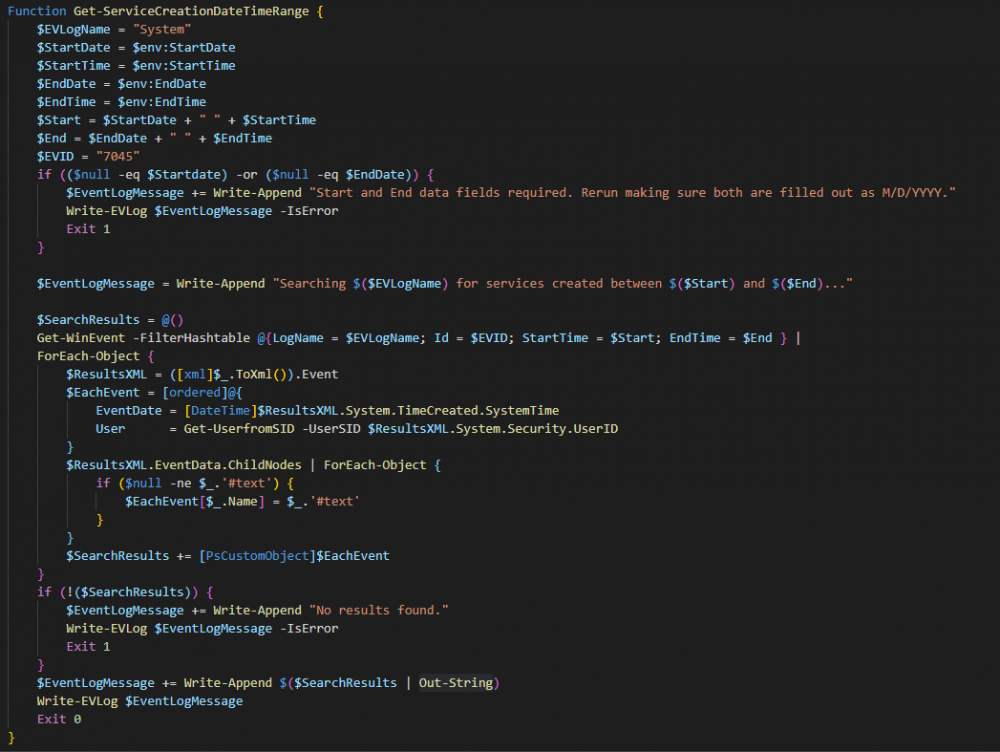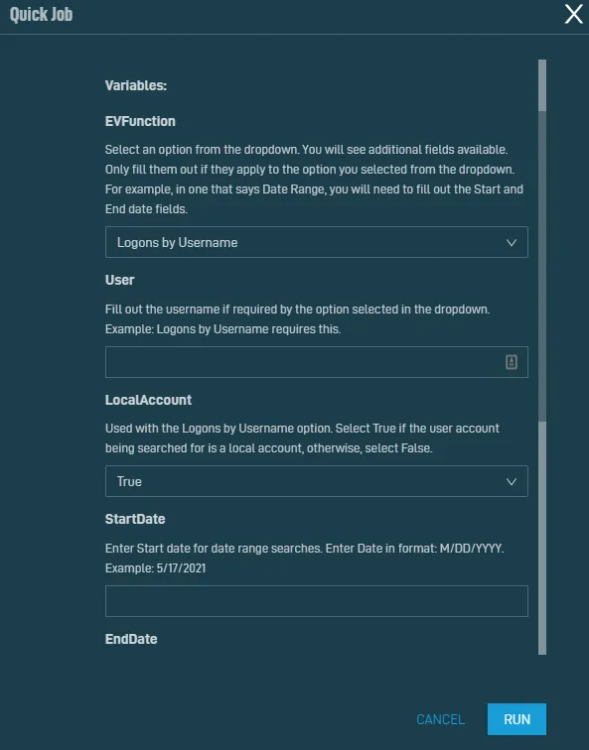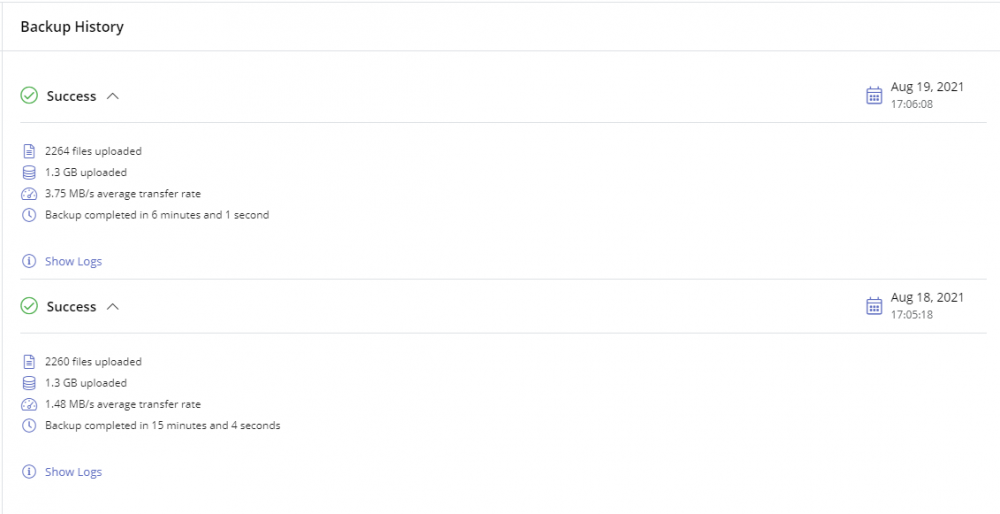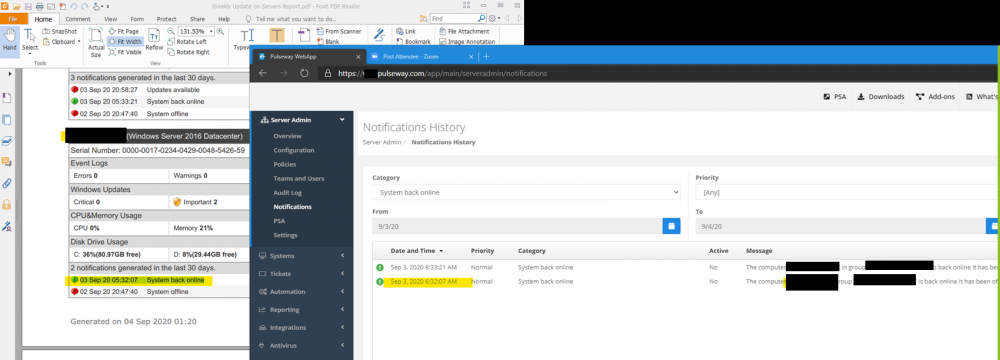Search the Community
Showing results for tags 'feature request'.
-
Need to search ticket to find work done that is posted in tech notes. We are having issues finding work performed for clients in the PSA search. The issue is that the ticket “Title” and “Details” do not always include the data you are searching for. (ie. When working with a supplier, we get info from them (ticket numbers or data) that we put in a ticket and can not search for.) It would be nice to also search the “Time Logs” – Notes and Internal Notes fields for key words to find data.
-
We'd like to use workflows when a specific eventlog item is triggered. Now everything will send by email if you use workflows. + It is possible to send an email when a new system is registerd. It would be nice if you can also have a item in the workflow which states the total of the specified group. Thanks
- 1 reply
-
- feature request
- configuration
-
(and 1 more)
Tagged with:
-
Hello, I need the ability to set up ticket templates that only a few members of my organisation can access. For example a "New Starter" or "Leaver" template pre-populates loads of info, saving time for my admin team, but if I give everyone in the organisation access to these templates they will do what people do and attempt to circumvent the admin team. Is this something we can see in the near future? Seems like a simple enough thing to implement. You already have a couple "share with..." options on the template creator menu, perhaps we just expand on this a bit? Thanks
-
Let me start off by saying this is not meant with any kind of hate or ill will. I very much love the Pulseway product overall, and I have been using it for a quite a number of years now. I very much want to see Pulseway continue to improve and catch up to a lot of the other RMMs out there by addressing some obvious "misses" with certain aspects of the software. This is going to be a bit of a novel but I hope the Pulseway staff and the community give it a read and feel free to comment, add suggestions, etc. The below items are too much to put into a bunch of separate feature requests. I apologize in advance if this is too much in one spot Interface/Web UI: Ability to completely remove or hide default scripts. Should also be able to delete individual ones within the default section. Ability to adjust script level permissions. There are some scripts I have written such as an MDM remote wipe type script that I want to be able to access within Pulseway if needed, or one of my higher tiered consultants but not my lower tier. I should be able to assign some sort of permissions to scripts to hide/show them based on security group, level, or team. A full inventory of the machine should be performed by the agent and visible in the web portal. This is a basic function of every other RMM I've used. I should be able to see all services on the machine, just like Pulseway looks at all applications installed. Services should then be selectable to be managed or not, or allow the ability to manage them right from that screen. Windows Updates - We should be able to easily see a list of installed updates on the machine without having to go back through Patch Policy History. The list could easily be populated on the Windows Updates section that Pulseway currently has. Dashboard - Needs more adjustable widgets. Patch status should be available as a dashboard widget with the ability to drill down to site/customer or filter for those things when creating the widget. PowerShell Console - Should be able to press up or some other key to be able to access, select previous inputs from that active session. Scopes - From the Scopes creation page, we should be able to then click on the Scope and see all the machines that the Scope includes. This would be a much easier and faster way then having to go to Systems and then select the Scope and drill down that way. Exclusions - We are unable to create exclusions for alerts. The answer is to move the machine to it's own group, and apply a new policy to that machine. This is certainly not ideal as 1, if you logically group your machines together, then splitting one out is a mess and even more importantly, then more policies created, the more you have to worry about going in and updating them when you want to change 1 thing. The less policies that have to be maintained, the better. Scripting: Input Variables - My single biggest issue with scripting currently is the lack of usability with the current custom input fields. It takes more time to click add/edit and input what is needed into the UI, then it does for me to just declare the same variables at the start of my script when writing them. Have script input variables work as environment variables, and they can be filled in at the time of script run. So if I have script to search for something by date range, I can create 2 input variables, Start & End, and leave them blank. When I got to run the script, it pops up a window with the available custom input variables allowing me to fill them in at that time. Here is an example of a popup window at the time of run for another RMM tool I've used. All these variables are declared in the script as $env:customvariablename, and then inside the RMM portal, at the script creation screen, they are entered in, much like you can with Pulseway, and you can select the type of variable. Variable value, Boolean, selection (dropdown). Whatever is selected/inputted at the time of ran is simply passed to the $env:customvariablename that corresponds to that input variable. I've shown the 3 areas of how this works to show the complete idea behind this in the attachments. Site Variables - Pretty much the same concept as above, except these are created at the site (customer) level instead of the script level. They are called in the same fashion as above. This would allow for much greater flexibly around scripting as many clients have license specific software that needs to be installed and being able to set a site(customer) level variable that gets pulled automatically when the script runs, would allow for 1 script to be made and ran across multiple clients at a time without having to edit the script or make copies with the unique license key for each. It would simply read from the site variable when running and insert whatever is in that site variable field. Output of scripts (the content) in the push notification or email alert. If I schedule a task to run on a recurring basis and I get a failure notification, being able to see why is incredible helpful. Or, even if it's a success, there are plenty of use cases why seeing the output is needed. If I'm running a script to collect xyz info across multiple systems, being able to easily see that in a central spot on the notification or email is imperative. I shouldn't have to log into Pulseway and check each machine or check the task and look through the report. Tasks - We should have the ability to schedule tasks to run much more frequently that once per day. I would like the ability to run a custom script that checks for something specific let's say, once an hour, which then writes to a custom event log that I then have Pulseway set up to trigger an alert from. This would be helpful in creating plenty of custom alerts based on Event Log errors but once a day is not frequent enough in some cases. The ability to select multiple machines and run a script against them on the fly without having to tag them or create a scope and run a task. When a task is completed and you are viewing the results, it would be awesome if you could click the machine and go right to it from there. It's a little cumbersome to be viewing the results of a task, specifically looking at ones that failed, and then having to click out of the report and go drill down to each failed machine. Workflows As I understand it, the entire workflow idea works around something that generates a notification. This creates a big issue with workflows in the sense that, we are limited to whatever Pulseway deems an acceptable "condition" or filter. What would make workflows amazing, would be essentially turning them into "custom monitors". What I mean by that is I create a script that let's say reads some random programs event log because my customer needs to know when this particular software generates a specific error, (and no, it doesn't write this error to any event log). There is no built in way to approach this with Pulseway. If I could simply create a workflow and choose to run a script as the initial item, and then based on the exit code of that script, do other things from run a script to fix, generate an alert to my team so someone can go in and look at what is causing the error and resolve it, etc. I could apply that workflow to any systems I wanted, and set it to run every 10 minutes, an hour, whatever, and when it detects the event, again, based on how the script was written, it triggers the workflow or the alert. As in the example above, if I set it to run every 30 minutes and look for "if error exists", if it does, it then creates an alert so that myself and my team get notified. But it would also allow the workflow to perform additional steps as remediation if desired. Another useful example of what I'm trying to explain, is perhaps I want to perform a certain set of steps based on a tag setup in Pulseway. I should be able to set up a workflow against a tag or against a scope and set it to run every so often. When a machine is then given that "tag" the workflow triggers and performs the steps assigned. This goes along with 4 under scripting. In the same vein, workflows should be triggerable off the result of a script. In other words, I shouldn't HAVE to make it an event log entry. It would be great if I could set up a script via a task, and then set a workflow to check results of that script and allow me to choose either to alert or trigger a workflow on either a success of failure, whichever I wanted at that time. Cloud Backup: I would LOVE to use Pulseway's built in cloud backup, but there are just too many flaws / missing items in it currently. Scheduling - The only current options are every day, every 2, or every 3 days. All backup solutions I've ever seen, give you the ability to select which day(s) you want the backup to run, be it every Monday, or any multiple combination of days. We should also have the ability to select the TIME the backup will take place. Right now, it uses the time the backup job was created, so if I want a job to happen at 2 AM, I have to stay up until 2 AM to schedule that job for the first time. This is a very shocking miss on the backup front. Ability to exclude certain file types (by extension) is needed. Notification on job success or job failure is a MUST, not how it current is where it notifies you once it reaches below a targeted % range. The ability to see the used space. Since your cloud backup works off either 500GB or 1TB licenses, we need to be able to see how much space is current in use per machine so we can plan to take the needed action should the backups start approaching the limit. A report on the files backed up. Since this is a file only backup type, it's imperative to be able to see a list of all files backed up during the job, and if they were successful, failed, or skipped. The ability to specify if the backup is considered a failure based on % of failed or skipped files is also needed. For example, if I'm targeting 1000 files, perhaps 5 failed isn't a concern to me, but if 300 fail, that's a failed backup job IMO. Therefore, having the ability to say if 10% (or whatever amount I want) of files fail to backup, the job is considered failed. In general, during my demo of this, I've had some concerns which your staff did witness directly: The next backup date seems to fluctuate between the current day and next day if you sit that the backup status screen of Pulseway. The initial dig into a backup job, showed folders that I had excluded, were still present and you could drill down. However, after mounting a recovery to explore, the interface then hid all the folders not backed up. Concerning if it's collecting any data from folders I specifically didn't include in the target paths. You can see from the image below, it backed up 2 days in a row, almost the exact same amount of files and used the same amount of space. This is a test VM which had no changes in the test target directories, and yet the 2nd day it did what appears to be a full backup again. Subsequent days seem to have improved and the file count went down to a more expected level. Here are some feature requests I submitted around some of the points above: https://pulseway.featureupvote.com/suggestions/189283/more-robust-input-and-site-variables https://pulseway.featureupvote.com/suggestions/189917/patch-status-dashboard-widget https://pulseway.featureupvote.com/suggestions/214566/more-flexible-task-scheduling https://pulseway.featureupvote.com/suggestions/217128/exclusions https://pulseway.featureupvote.com/suggestions/202867/attach-files-to-scripts https://pulseway.featureupvote.com/suggestions/202092/monitor-services-through-portal https://pulseway.featureupvote.com/suggestions/203512/system-type-as-workflow-condition
- 18 replies
-
- configuration
- feature request
-
(and 2 more)
Tagged with:
-
You can now trigger workflow executions from Event Logs notifications and evaluate Event Id, Level, Message, Name, Source and Filter Title in conditions to build even more customisable workflows for your IT processes.
- 1 reply
-
- configuration
- feature request
-
(and 1 more)
Tagged with:
-
I would really like to see an outlook add-in that can be pushed through office 365 to all users that would allow them to submit tickets with drop down menus for ticket type, sub-type, priority and description.
- 1 reply
-
- feature request
- webapp
-
(and 1 more)
Tagged with:
-
TL;DR: Align timezones across reporting and web interface. Request: When raised during our trial to engineering, the feedback is that browser displays local time, and reports are generated using UTC. The misalignment is visible in my example shown where a report shows a system was back online at 05:32:07, but it actually and factually came back online at 06:32:07. Suggest either including "UTC" in the report, or allowing time zones to be configured globally or per site. Also noticed, that the "Generated at 04 Sep 2020 01:20" footer on the report is 6 hours behind GMT (report generated 07:20am GMT), so this could also do with being aligned accordingly.
-
I like automation and workflows but it has one big drawback. It can only run PW scrips or linux bash scripts. we cannot fire off any pulseway RMM internal functions. for example. Lets say when a computer checks in i want to launch a 3rd party Patch Management policy. Right now i can only do this on a timer or manually or set the policy for if missed, i can not make this part of a workflow. another thing i can't seem to do is have a workflow repeat. For example. i have a workflow that says when a computer registers it checkes and installs updates. Oviously for windows this needs to be done more than 1 time. I cannot find a way to have it check and then recheck until all windows updates are installed (maybe this is possible and i just dont know how)
-
We use Puleway Webapp (RMM) and PSA. I have to setup to different logins (PSA is on SAML) for access. Is there any plans to allow us to link and integrate these two logins?
-
The ability to just pull your phone out and run a Ansible playbook would be amazing. Maybe even get run status or just the output of whatever playbook was run. This would add a crazy amount of flexibility to Pulseway.
-
Hi there, This might be a bit of a long shot - but I have an end client who's interested in deploying custom Teams issues with Pulseway (as there aren't many users in-office for obvious reasons). I've attempted to deploy this by pushing a batch script, to copy the backgrounds from a shared location. The backgrounds folder in question is located in the user's roaming appdata (%appdata%\Microsoft\Teams\Backgrounds\Uploads). For this reason I wasn't able to use %username% correctly in my batch script, as the script is being run by some Pulseway service, rather than as the local user account. Please let me know if you've any ideas and have a great day. Cheers, Joe
-
- configuration
- feature request
-
(and 1 more)
Tagged with:
-
Would it be possible to add the current logged in user for each pc to the header info that shows in the middle panel. We manage several hundred pcs and the computer name of ASSET-1234 does not tell us whos using it at that time. Most end users do not know their computer names. So trying to find the computer a user is on is sometimes difficult. Having this info at hand in the search list would help that a lot. i am only thinking this information for workstations, servers could potentially have multiple users logged in at the same time and this information would not be as useful (not to mention not enough space) I have included a mockup of one way this could be done. Also adding the ability to search for a current logged in user would be helpful.
-
In trying to diagnose systems, often we need to be able to connect to a system before the user prompt for login. This allows us to see statuses of updates, rollback errors, etc.
-
Treating user groups more like AD user groups would allow more granularity of access and less duplication of security roles.
-
It would be nice to be able to add negative keywords to scopes (i.e. Does not have tag). We currently use a script to automatically update the system name to include the username, but there are some systems that we want to keep a static name so they are easier to identify. Currently we have to separate these into their own groups in order to keep them statically named.
-
After coming from another competitor, one of the major things we are missing is a site wide software list with the ability to list systems with software and remove it from multiple systems. Ideally, initially it would show all software, but would allow you to filter software by name. At that point you would be able to click in and see installed systems with installed version.
-
Remove full automation scripts from [trace.log]
Martin Stevnhoved posted a topic in Feature Requests
Hi. If it is possible I would like to exclude full automation scripts from the diagnostics log "trace.log". In normal situations it is fine with just an indication of the execution with the script name. I guess you could add one more checkbox like "Include full Automation Scripts" in settings, and let it be disabled as default. Best Regards, Martin. -
I was getting the policies configured for my new setup and I noticed that Patch Management only allows you to select categories of patches and just decide to install them as a whole or not. Unless I'm missing something, there's no ability to approve or deny patches on an individual level. This is a somewhat vital part of any RMM suite as we may often need to decline individual patches that are known to be causing issues (a common problem with Windows 10 these days.) I'd say this is something vital for Pulseway to get implemented as I've worked with a number of RMMs over the years and it's the first one I've seen that doesn't offer this.
-
Remote Control really needs the ability to both trigger a reboot and to automatically reconnect when the system you're connected to completes the restart. Having it immediately disconnect when a reboot is triggered (usually if it's running as a service, it should be able to hold the session open for things like the first phase of installing Windows updates) and having to manually try over and over again to see if the machine has completed its reboot is really frustrating when you're trying to solve an issue remotely that requires a lot of reboots or even when you're just trying to do a number of updates to a system.
-
I just signed up for Pulseway to monitor a small client of my side business. I am in the process of setting up patch management for workstations. I would like the systems to prompt the end users to reboot upon installing updates but Pulseway seems to be very restrictive in how it lets you set that up. It looks like all I can do is have it reboot immediately or give the users a 5 minute warning with a generic message. I work with a competitor product at my day job and it allows us to specify whatever message we want, set whatever timer amount we want and allow the users to defer the updates as many times as we want or force a reboot after a certain number of deferments. It does not appear Pulseway provides any of this customizability. It would be very nice to have these options so I can have choices other than forcing end users to reboot during the day or having systems that potentially go days without a reboot after installation. Thanks!
-
After playing around in my trial account for a bit, I have a few suggestions regarding policy configuration. Allow the creation of policies that inherit settings from other policies and track which settings were overridden. This would allow MSPs to create one or two "Global" policies (Servers/Workstations) as a base, and then create individual policies (for each client) that inherit settings from those global policies. Allow overrides to policy settings on specific systems, track which systems have policy overrides in place, and allow reverting the overrides to the policy defaults. Allow attaching scripts/tasks to policies to run during on-boarding (as in, when the Pulseway agent is initially installed). Instead of having separate Patch Management policies, group those settings with the System policies so they can be applied all at once. Alternatively, allow attaching Patch Management policies to System policies.
- 1 reply
-
- feature request
- configuration
-
(and 1 more)
Tagged with:
-
Would it be possible to expand the number of API endpoints available for the RMM? While the API is useful for gathering information about systems, it doesn't have much in the way of being able to perform many built-in operations that exist in the web application, like check for and install patches, run single line commands on the system, being able to run scripts on a system and not just tasks, add tags to systems, etc. This would be great for creating custom automation and would help with removing a lot of tedium in cleaning up small alerts.
-
Hi, i´m testing this RMM atm. Is it possible to implement WOL on a Probe? For example choosing the probe then the Machines Show up which are on the same Network or same Customer and Option to do WOL. If you´ve many Machines to Manage You would Need to Edit Firewall Rules for each Machine and Edit the Settings of each machine.Would be way to much work.
-
I know this would be a major change in the reporting interface, but how about an option to interact with the results of a report. Maybe one can choose an additional "Report Format" when editing a report and have an option for Interactive? When this is enabled the output of the report is immediately displayed in web format with hyperlinks to automate certain tasks by sending a back-end task/script to the agent. For example: Report Interaction Script Task (Relayed to the agent) Applications link next to each agent to uninstall the application Assets link to create asset tag if none exist OS Patching link to assign Policy / Update now 3rd Party Patching link next to each agent to update the application Drive Usage link to run a temp files cleanup job Anti-virus install AV / Run Scan / Update (not sure how this ties in to the existing Kaspersky deployment) ...














